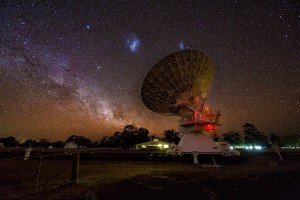
The Large (centre left) and Small (centre right) Magellanic Clouds are seen in the sky above a radio telescope that is part of the Australia Telescope Compact Array at the Paul Wild Observatory in New South Wales, Australia. Image: Mike Salway
Visible in the southern night sky, the LMC and SMC are dwarf galaxies that orbit our home galaxy and lie at a distance of 160 and 200 thousand light-years from Earth respectively,
“There were hints that this magnetic field might exist, but no one had observed it until now,” says Jane Kaczmarek, a PhD student in the School of Physics, University of Sydney, and lead author of the paper describing the finding.
Such cosmic magnetic fields can only be detected indirectly, and this detection was made by observing the radio signals from hundreds of very distant galaxies that lie beyond the LMC and SMC. The observations were made with the Australia Telescope Compact Array radio telescope at the Paul Wild Observatory in New South Wales, Australia.
“The radio emission from the distant galaxies served as background ‘flashlights’ that shine through the Bridge,” says Kaczmarek. “Its magnetic field then changes the polarization of the radio signal. How the polarized light is changed tells us about the intervening magnetic field.”
A radio signal, like a light wave, oscillates or vibrates in a single direction or plane; for example, waves on the surface of a pond move up and down. When a radio signal passes through a magnetic field, the plane is rotated. This phenomenon is known as Faraday Rotation and it allows astronomers to measure the strength and the polarity—or direction—of the field.
The observation of the magnetic field, which is one millionth the strength of the Earth’s, may provide insight into whether it was generated from within the Bridge after the structure formed, or was “ripped” from the dwarf galaxies when they interacted and formed the structure.
“In general, we don’t know how such vast magnetic fields are generated, nor how these large-scale magnetic fields affect galaxy formation and evolution,” says Kaczmarek. “The LMC and SMC are our nearest neighbours, so understanding how they evolve may help us understand how our Milky Way Galaxy will evolve.”
“Understanding the role that magnetic fields play in the evolution of galaxies and their environment is a fundamental question in astronomy that remains to be answered.”
The paper is one of a growing number of new results that are building a map of the Universe’s magnetism. According to Prof. Bryan Gaensler, Director of the Dunlap Institute for Astronomy & Astrophysics, University of Toronto, and a co-author on the paper, “Not only are entire galaxies magnetic, but the faint delicate threads joining galaxies are magnetic, too. Everywhere we look in the sky, we find magnetism.”
The paper appeared in the Monthly Notices of the Royal Astronomical Society.
-30-
Detection of a coherent magnetic field in the Magellanic Bridge through Faraday rotation
Jane Kaczmarek
School of Physics
University of Sydney
e: jane.kaczmarek@sydney.edu.au
Prof. Bryan Gaensler, Director
Dunlap Institute for Astronomy & Astrophysics
University of Toronto
p: 416-978-6623
e: bgaensler@dunlap.utoronto.ca
w: dunlap.utoronto.ca
Chris Sasaki
Communications Co-ordinator
Dunlap Institute for Astronomy & Astrophysics
University of Toronto
p: 416-978-6613
e: csasaki@dunlap.utoronto.ca
w: dunlap.utoronto.ca
The Dunlap Institute for Astronomy & Astrophysics at the University of Toronto is an endowed research institute with over 60 faculty, postdocs, students and staff, dedicated to innovative technology, ground-breaking research, world-class training, and public engagement. The research themes of its faculty and Dunlap Fellows span the Universe and include: optical, infrared and radio instrumentation; Dark Energy; large-scale structure; the Cosmic Microwave Background; the interstellar medium; galaxy evolution; cosmic magnetism; and time-domain science.
The Dunlap Institute, Department of Astronomy & Astrophysics, Canadian Institute for Theoretical Astrophysics, and Centre for Planetary Sciences comprise the leading centre for astronomical research in Canada, at the leading research university in the country, the University of Toronto.
The Dunlap Institute is committed to making its science, training and public outreach activities productive and enjoyable for everyone, regardless of gender, sexual orientation, disability, physical appearance, body size, race, nationality or religion.
###
